______________
Regina José Galindo Tierra, 2013
‘In 2012, José Efraín Ríos Montt, the former President of Guatemala, was prosecuted on charges of genocide, terrorism, and torture; Regina José Galindo’s video is a haunting reinterpretation of the atrocities recounted during his trial. Tierra begins with the artist standing naked in a verdant field, the tranquility of which is shattered by an earth-moving machine. Here, Galindo alludes to the incident in which innocent citizens were murdered and cold-heartedly buried in a bulldozer-dug mass grave. The stark contrast between the machine’s huge, armored bulk and the artist’s vulnerable body captures the injustice of Montt’s regime, while the abyss that grows around her serves as a poignant symbol of the despair and alienation born of political violence in general, and Montt’s post-conviction acquittal in particular.’

______________
Yusuke Asai yamatane, 2014
‘Japanese artist Yusuke Asai uses nothing but natural pigments and water to create his intricate large-scale murals that he calls “earth painting”. The materials of his works are almost always collected on-site, or site-specific, made using a variety of different textures and types of local mud, dirt and dust. Each piece begins with applying masking tape to walls, then drawing shapes of plants and animals over it to create infinitely swirling images. Asai rejects commonly used art supplies that are manufactured in favor of mud, a sediment where microscopic organisms make their home, for its special connection to nature.’

Deinstallation
_____________
Claes Oldenburg Placid Civic Monument, 1967
‘The piece, one the earliest examples of so-called earthworks sculpture, was a six by six by three foot ditch (conceived as a kind of negative-space sculpture) excavated as part of an exhibit entitled ‘Sculpture in Environment,’ for which a number of different artists were asked to create public art in various locations (of their choosing) around New York City; in this case, behind the Metropolitan Museum of Art, near the Obelisk. Oldenburg hired two off-duty gravediggers, for $50 each, who dug the hole while he filmed–a few hours later, the hole was was re-filled.’
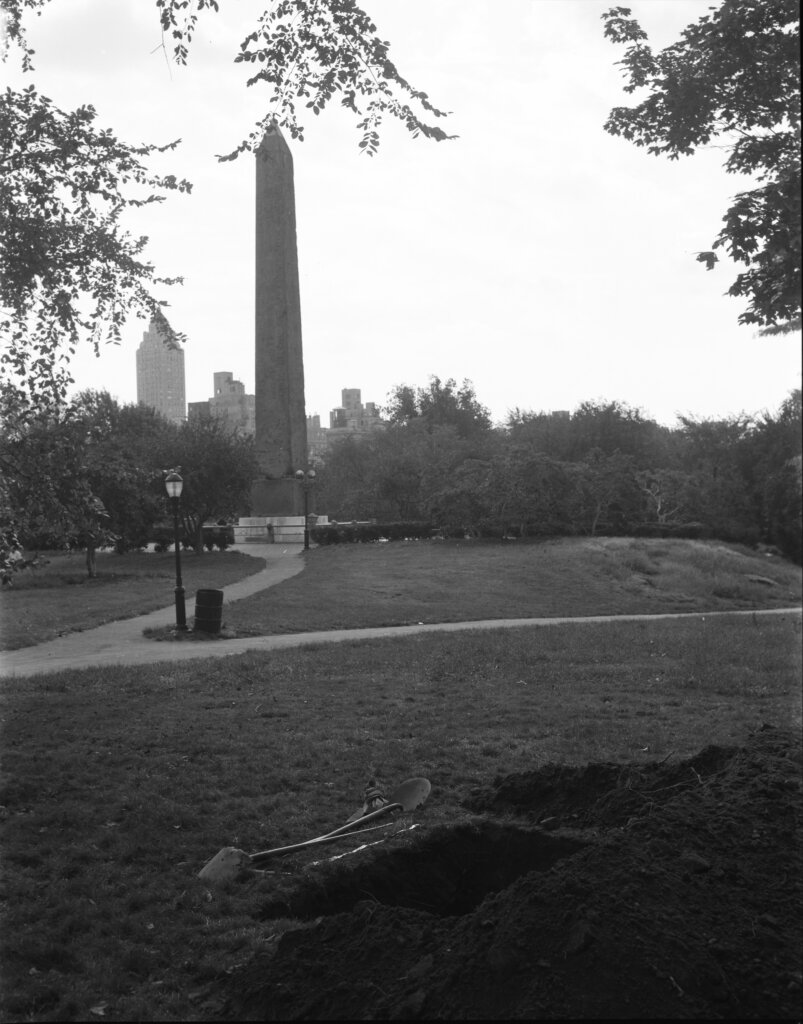
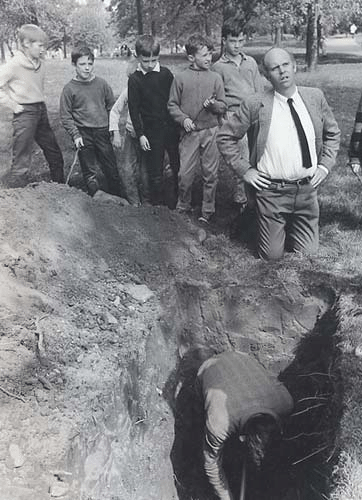

_____________
Richard Long Chicago Mud Circle, 1996
Mud on wall
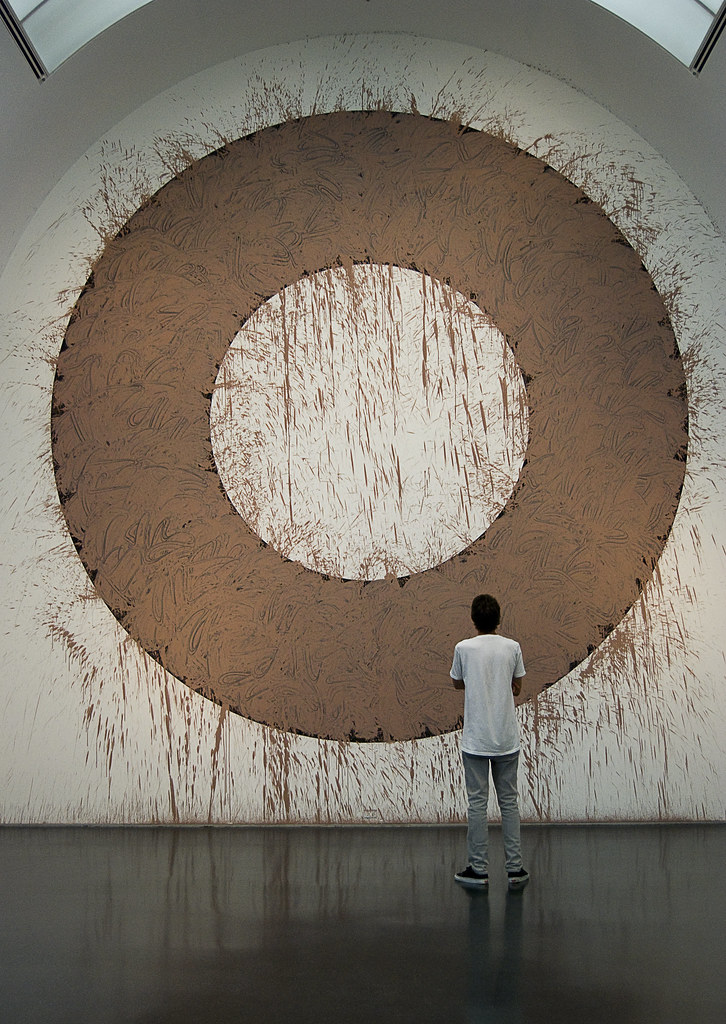
_____________
Robert Rauschenberg Mud Muse, 1968–1971
‘In Robert Rauschenberg’s fifty-year-old artwork “Mud Muse” (1968–1971) sonic vibrations create random bubbles in a large, open, vat filled with synthetic sludge.’
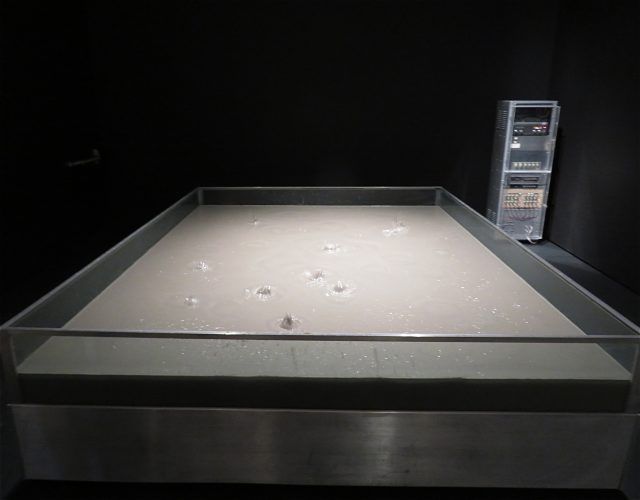
______________
Shiraga Kazuo Challenging Mud, 1955
‘How might an artist react meaningfully in the aftermath of Japan’s defeat, and its near total destruction, at the close of the Second World War? Kazuo Shiraga’s 1955 performance work, Challenging Mud, proposed a rethinking of the boundaries and definitions of art making to clear a path forward. Shiraga performed his body/mud composition in the front courtyard of Tokyo’s Ohara Hall three times over the run of the first Gutai Art Exhibition. The photographs that survive record the different effects of each iteration of the performance. Each time Shiraga molded, smeared, and grappled with a different combination of cement, kabetsuchi, and aggregates such as sand and gravel. Somewhere between painting, sculpting, and wrestling, Kazuo’s radical actions defied categorical boundaries.’
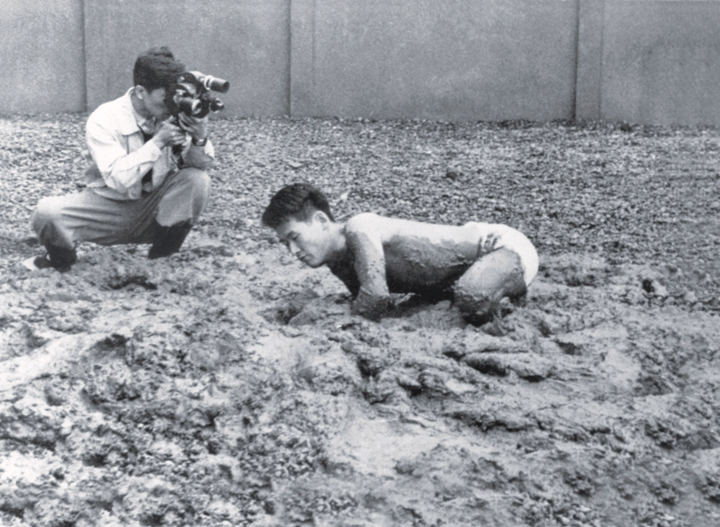
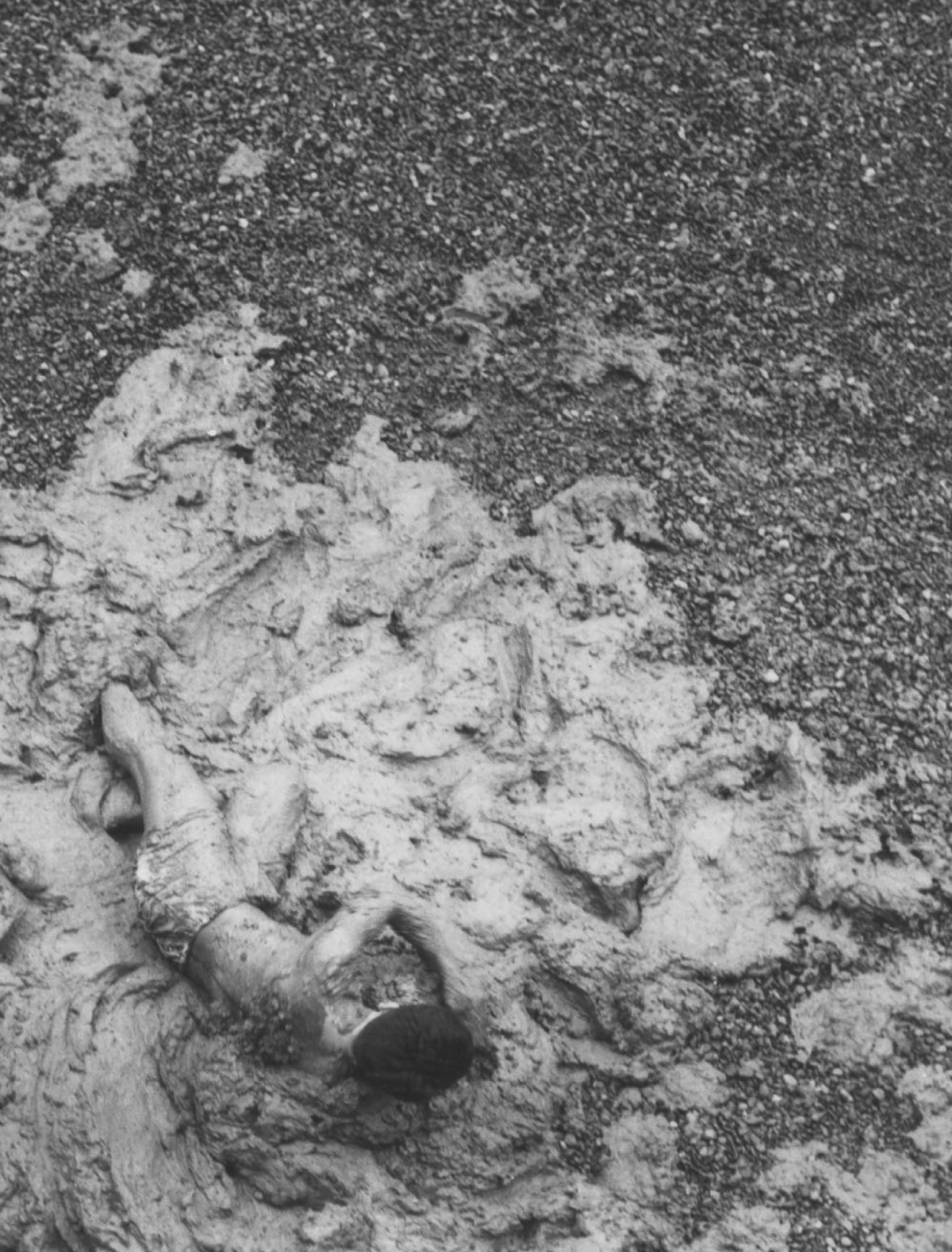
______________
Sen Uesaki, Daishiro Mori & Grand Openings Challenging Mud as Archive, 2011
‘After Shiraga Kazuo’s performance-painting, Challenging Mud.
Shiraga executed Challenging Mud on October 19, 1955, for the opening of 1st Gutai Art Exhibition, in the front yard of the Ohara Kaikan in Tokyo.
I challenged mud.
After a series of e-mail exchanges with Ei Arakawa,
who told me, on July 15, 2011, that he would soon present a 13-day performance with his group, Grand Openings, with daily changing programs.
I challenged mud.
After I confessed to him that I didn’t have a formal dress to wear for Grand Openings’ “Formal Dress Day” (7/27).
He wrote, “then please come also 23rd when sen is doing a challenging mud. you could bring a change of clothes. only historians and archivists will be allowed to challenge mud.”
To this, I innocently responded: “that sounds cool.”
I challenged mud.
After I finally understood that he and Sen Uesaki intended to create a “metaphor” of archiving using Challenging Mud.
That Sen would play a metaphorical role of “gravedigger” (!?).
What’s a historian have to do with “metaphor”?
This historian is all about facts, if not just facts. But metaphor is not her forte.
I challenged mud.
After the artist finally figured out that the historian got to do what she got to do.
A wise move.
Only an artist would think of putting a historian in the mud pit.
A historian would put an artist in the mud pit.
I challenged mud.
After we decided to base our attempt on Shiraga’s 1st set, out of three sets he executed that day.
The 1st set was least challenging, it was a “fake.”[ii]
Because the mud was hardening and became slippery, as the artist waited around for a press person to arrive. It rained, it got colder, and journalist Jean Launois came late.
So, the artist had to “fake.”
He “dug it up with my knees, punched it with fists, and grasped it by fingers.”
I challenged mud.
After Ming Tiampo decided to join our attempt by playing the role of photographer.
She is another historian. She happened to be in town to work on a forthcoming Gutai show at the Guggenheim.
Without the presence of the press, our attempt would have been incomplete.
Gutai’s performative works were either press events or onstage presentations.
Without the effort of self-documentation, we would have been disloyal to Gutai’s tradition.
So, Ming would play the double role of a press photographer and a documenting member.
She requested the use of a ladder. A wise move.
I challenged mud.
After I decided my outfit.
Shiraga wore only a pair of white shorts. Otherwise, he was bare.
Because of the impurity of his mud, his body was heavily cut and bruised.
In the 2nd and 3rd sets, he “pushed it with my shoulder, rather than using my hands; I gave a final flourish to it, by twisting my body.”
No wonder, he got cuts and bruises.
Safety was a big concern for me, even if I would follow the tamest 1st set.
Ei agreed: “We don’t have to hurt ourselves in [our] version.”
To protect my body, I acquired a pair of gray yoga pants, a half-sleeved black T-shirt, and a box of latex gloves. I would be well protected.
I challenged mud.
After I got my historical facts straight.
To the best of my knowledge, it would be the first ever serious attempt, whether by the artist himself or somebody else, since Shiraga executed three sets in 1955.[iii]
There was no instruction left, no recipe made for doing it again. Only his recollections and documentary photographs.
Looking at a photo of his 1st set, I visualized myself getting down on my knees, supporting my body with two hands also stuck in the mud, and shifting the mud with one of my knees.
I challenged mud.
After I arrived at MoMA at the appointed time, feeling somewhat scared. Trepidation or anxiety may be a more dignified word, but “scared” honestly expresses what I felt.
A shallow wood box was already there, at the end of the Sculpture Garden, just outside the glass partition. Chairs for the panel discussion (to follow my act) were arranged next to it. That was my stage.
The 8-foot square box looked smallish. Back then, one critic described the mud work he saw outside the Ohara Kaikan to be as large as three tatami-mats.
Bags of cement piled on one side, bags of garden soil piled on the other side of the box.
I challenged mud.
After Ei told me “Cement is toxic. Would you like to have vinegar for cleaning afterward?”
His words amplified my apprehension, also reminding me that I forgot to bring a pair of socks with me. We sent a member (or an associate or a volunteer?) of the group to get a pair, along with vinegar.
I challenged mud.
After we mixed soil and cement.
But, why cement?
Because Shiraga was not simply demonstrating an act of challenging mud,
he was creating a “painting” with mud.
That is to say, he painted with mud.
And he wanted his mud painting to last for 10 days, remain on view for the duration of the exhibition.
The mud, or kabetsuchi (wall mud), alone would have cracked.
Indeed, the second “painting,” made without cement cracked after a few days.
(Certainly, he was experimenting on that day; after the hardened mud for the 1st set, he apparently did the 2nd set without cement.)
I challenged mud.
After Ei and Jay spent more than half an hour creating the mud in the sweltering summer heat.
Shiraga brought in a small truck load of wall mud, about one ton (1000 kg) or so.
He mixed some 10 bags of cement in, the ratio being 3 parts mud and 1 part cement.
It took Shiraga (and his helpers, I imagine) a great deal of time to manually mix it.
We began by dry-mixing 3 bags of soil and 1 bag of cement, added more bags of soil, perhaps another 3 or 4, then poured in water bit by bit.
The sight of twigs and pebbles in “garden soil” horrified me, making me think of cuts and bruises I might get.
I challenged mud.
After we got what I thought would be an ideal consistency of mud.
We looked at the documentary photographs to get a sense of Shiraga’s mud.
I made a test-mixture in a cup.
Perhaps much thicker than pancake dough, a tad heavier than muffin dough, but not as dense as bread dough.
I challenged mud.
After the audience gathered around the box and Ei began the proceedings, introducing me to them.
I began by giving a talk. It’s a hands-on “demonstration lecture,” rather than “slide lecture.”
I explained the basics of Shiraga, a Gutai member who painted with his feet.
His foot painting embodied his concept that his “act” made his painting.
Challenging Mud extended his act/concept of painting from his feet to his whole body.
In 1955, the 2nd and 3rd sets he executed were more violent than the 1st “fake” set.
He dived into the mud, twisting in the mud and using his whole body to move the mud, to create his mud painting.
He struggled with mud until he was completely exhausted.
I challenged mud.
After clarifying that I was neither “re-staging” nor “re-enacting” Shiraga’s painting act.
I was merely making a “historical investigation” of Shiraga’s painting act.
Shiraga was a man’s man. He was a jock, practicing jūdō and sumō at school.
Back then, he was in his early thirties, he was an athletic, energetic male.
I am a middle-aged art historian, a female of delicate constitution.
I challenged mud.
After I first tested the mud’s consistency, explaining how he mixed his mud.
I poke my feet into the mud.
It felt wet.
More talk.
And I finally got down on four in the mud.
I punched the mud, moved it with my knees, grasped it and pushed it with both my hands, just as I imagined he had done.
I kept talking, as Ei stuck the microphone at me.
I kept my eye on the composition, spreading the mud like Shiraga had done in different directions to make a polygon shape.
I challenged mud.
After a while, I stopped, asking how much time had elapsed.
I was told: Only 3 minutes!
Shiraga continued 15 to 20 minutes before he was done.
Who could possibly compete with him?
Not me.
Ming urged me to continue, now perching atop the ladder.
With a change of her camera angle, I gave another round of punching, kneeing, pushing . . . playing for the camera.
I challenged mud.
Afterward, as Ming pointed out the historical accuracy would have demanded that I change into regular clothes and have myself photographed next to my “mud painting.”
That’s what Shiraga did, and the shot became a Gutai postcard.
But that was an afterthought for me. I hadn’t thought of afterward, except for how to clean myself.’
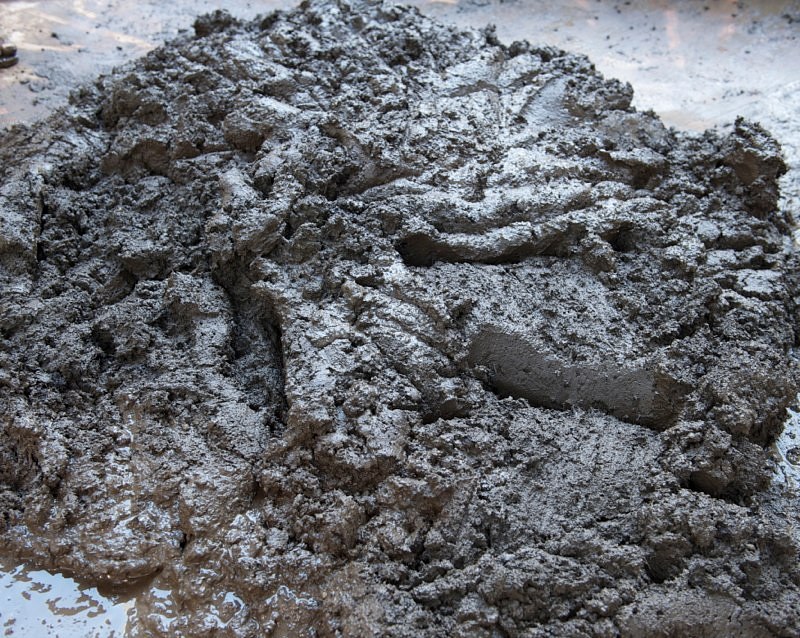

______________
Cveto Marsic Bath in Salty Mud, 2021
Oil on canvas
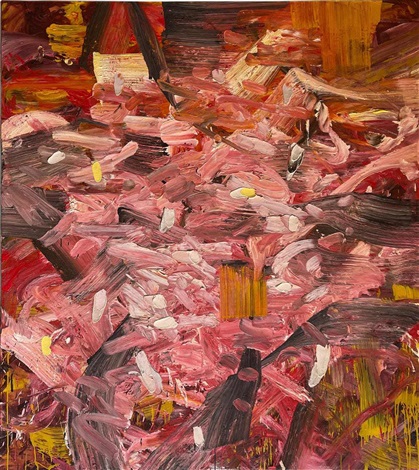
______________
Paul Seawright Mounds, 2002
‘In 2002 IWM commissioned Paul Seawright to respond to the war in Afghanistan, which had started the previous October. The resulting photographs of minefields show a seemingly empty landscape, which in reality is both lethal and inaccessible.’
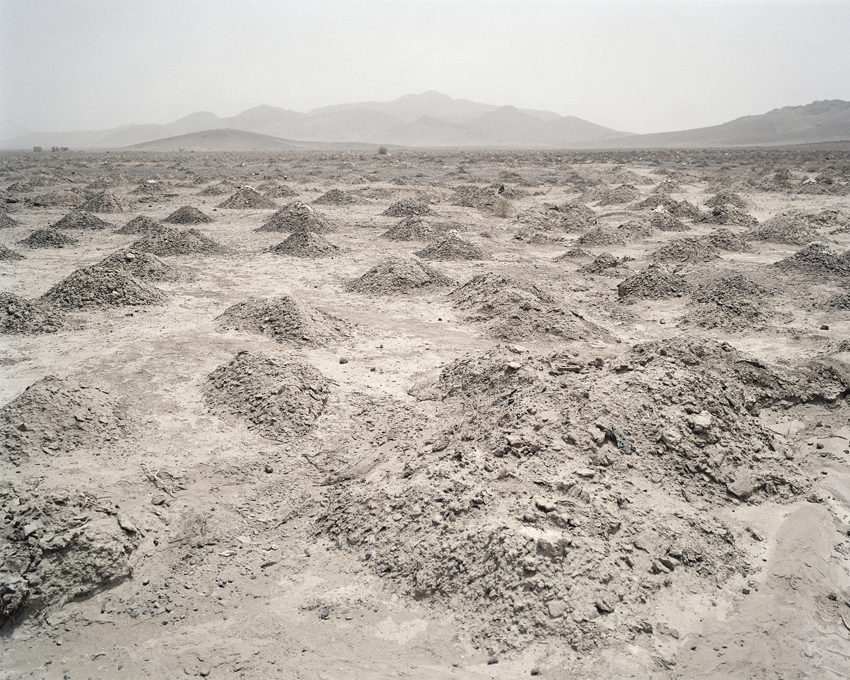
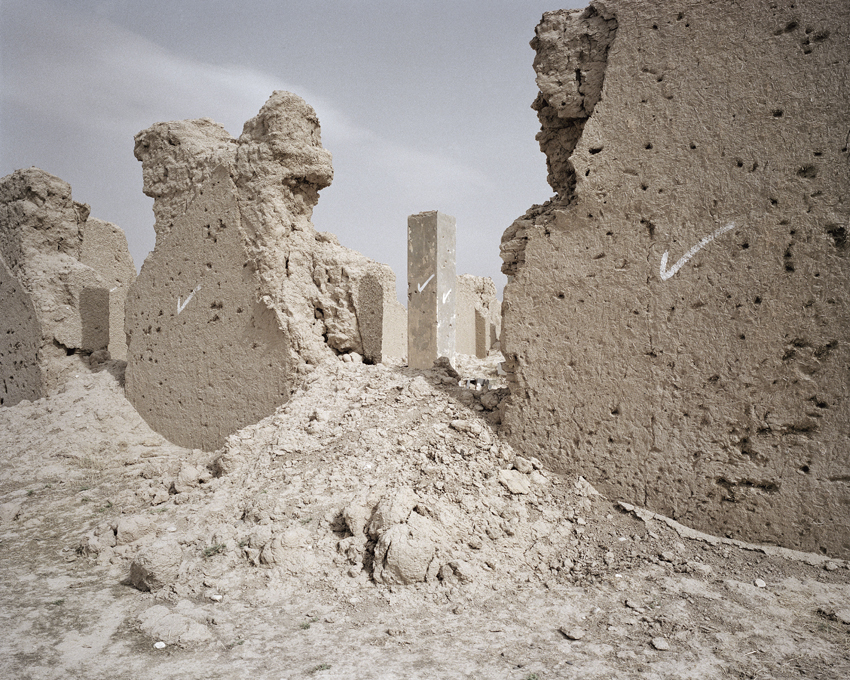
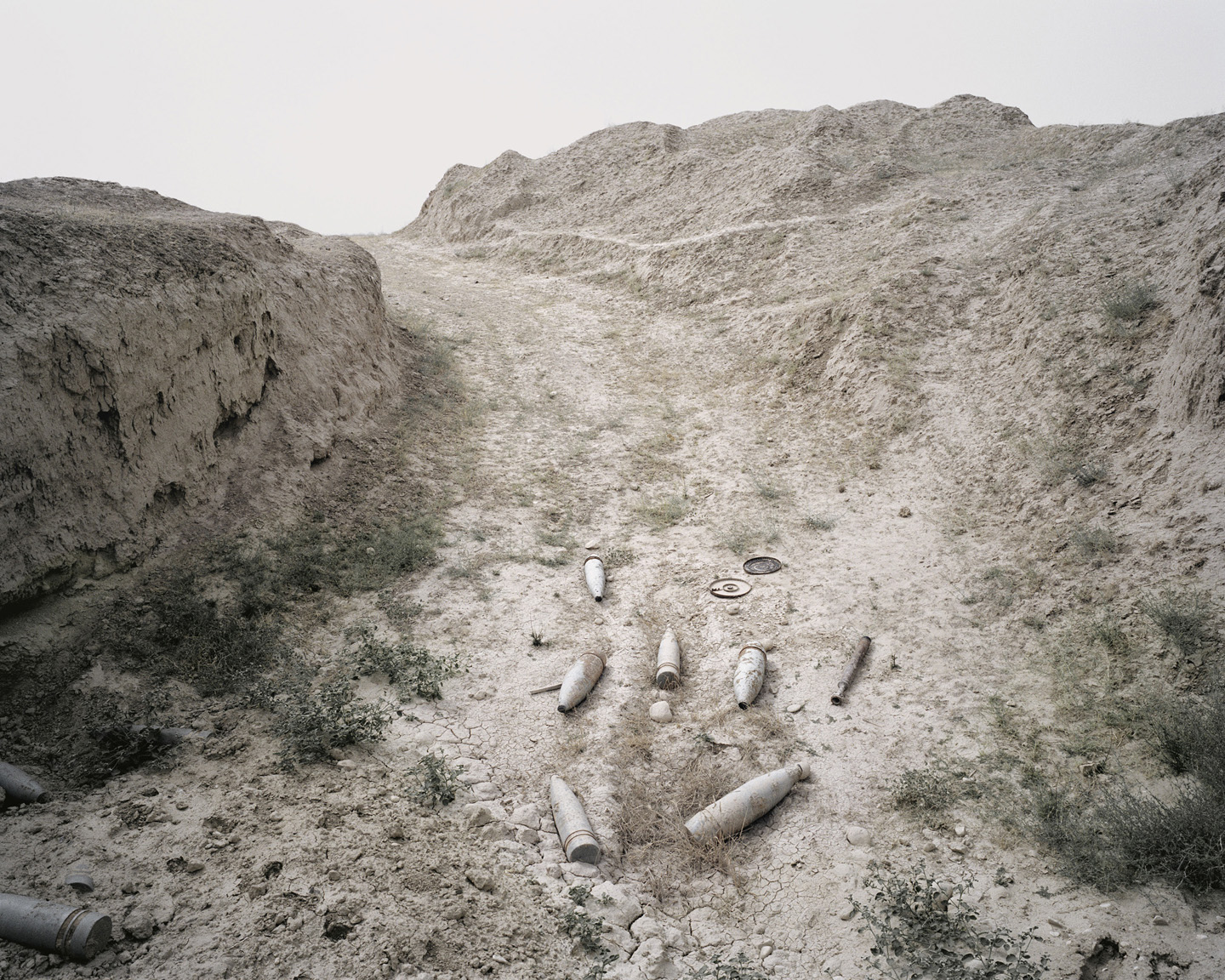
______________
Neil Leifer Joe Namath In The Mud, 1974
Photograph
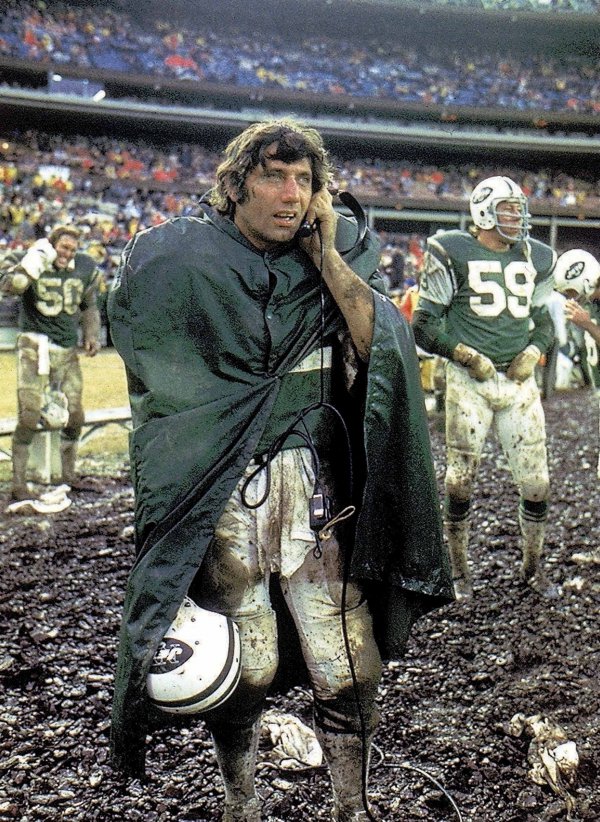
______________
Boyle Family Studies of Brown Mudcracks with Tire Tracks and Coal Dust, 1974
‘Boyle Family works simulating muddied land used resin, fibreglass and other binding materials. The effect was hyper real, a situation that took photorealist painting in the tactile direction of sculpture.’
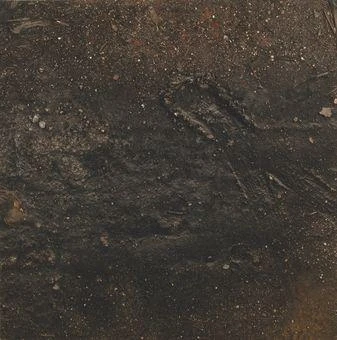


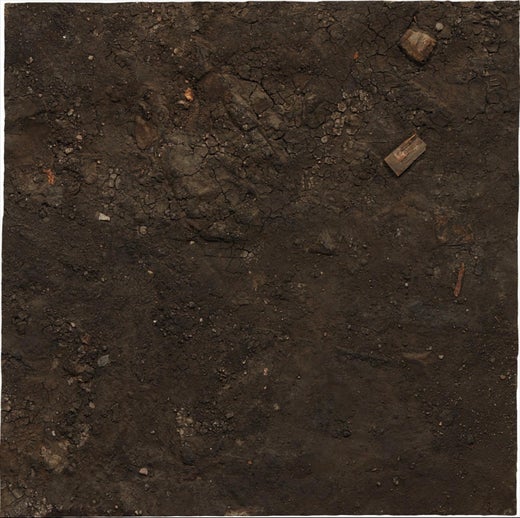
______________
Jennifer Allora & Guillermo Calzadilla Hope Hippo, 2005
Mud, whistle, daily newspaper, and live person

______________
Yan Bing Wind – Aridity, 2010
Electric Fan, Mud

______________
Allan Kaprow Trading Dirt, 1982-5
‘Kaprow produced the extended piece, Trading Dirt, when studying at the Zen Center of San Diego. He began by trading the soil in his garden for the “Buddhist dirt” of the center. This was then traded with various types of dirt collected by Kaprow. This sequence of events went on sporadically for three years, each exchange accompanied by an anecdote, recorded on film. Kaprow presents dirt as a metaphor that only gains meaning as it is exchanged or “traded.” This occurred in 1983, long after Kaprow had replaced the Happening with the Activity.’
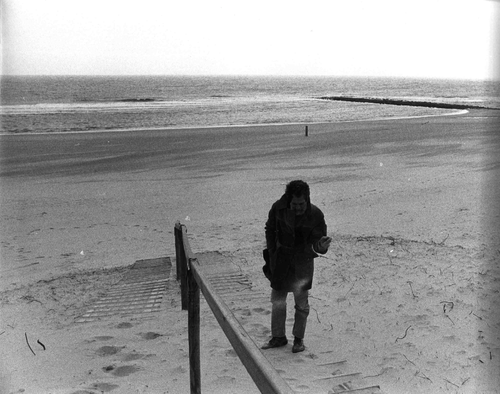

Allan Kaprow – Trading Dirt story
________________
Marcos Grigorian Strain, 1991
mud, metal strip, straw and glue on burlap laid down on board

______________
Li Binyuan Freedom Farming, 2014
‘In the countryside of China, land is a heavy issue. Each plot of land has its own destiny and character, and behind it is the people’s destiny. In 1999, when my father passed away in an accident, the land that he had cultivated was handed down to me. I was at a loss, and avoided returning to my hometown, ashamed to face the reality. But the problem was not solved because of my detachment, and my sense of identity gradually disappeared.
‘In 2014, I decided to use one of the plots of land to produce a work, to re-examine my relationship to my birthplace, which felt both strange and amiable. Finally, I made my peace through the fatigue that came from the constant falls into the field and the mud.
‘The name of the work, Freedom Farming, comes from the land certificate issued by the village committee, and from the sense of salvation that came from the performative act itself. Freedom Farming is a work about the dialogue between me and my father, and my present reality. I attempt to find a balance between the three, or save some things that are already lost through this behavior; also I want to confirm my sense of identity, of belonging, via this path. As for me, every jump of mine is a departure, and each fall is a return. Regardless of each departure or return, there’s always something missing.’
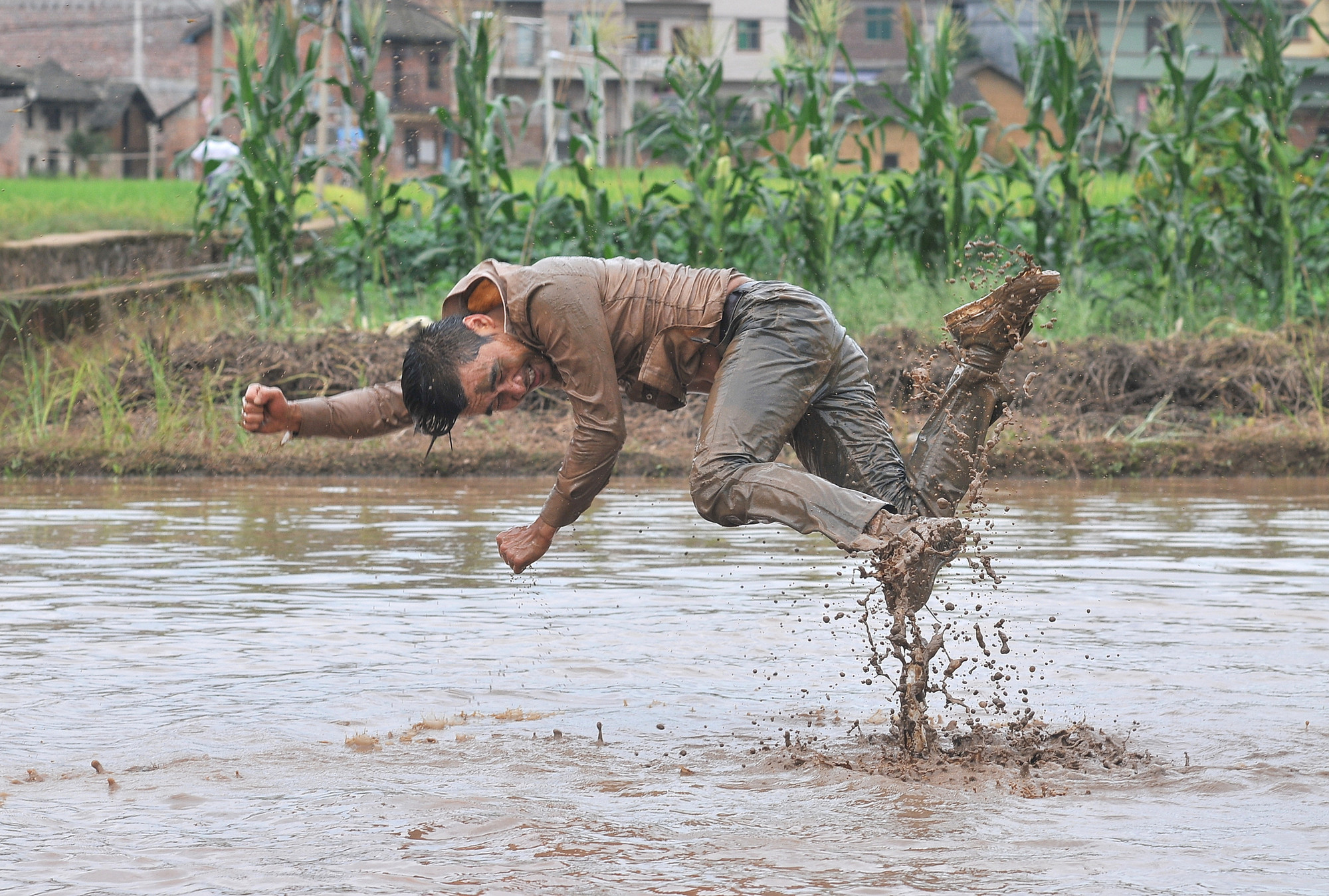
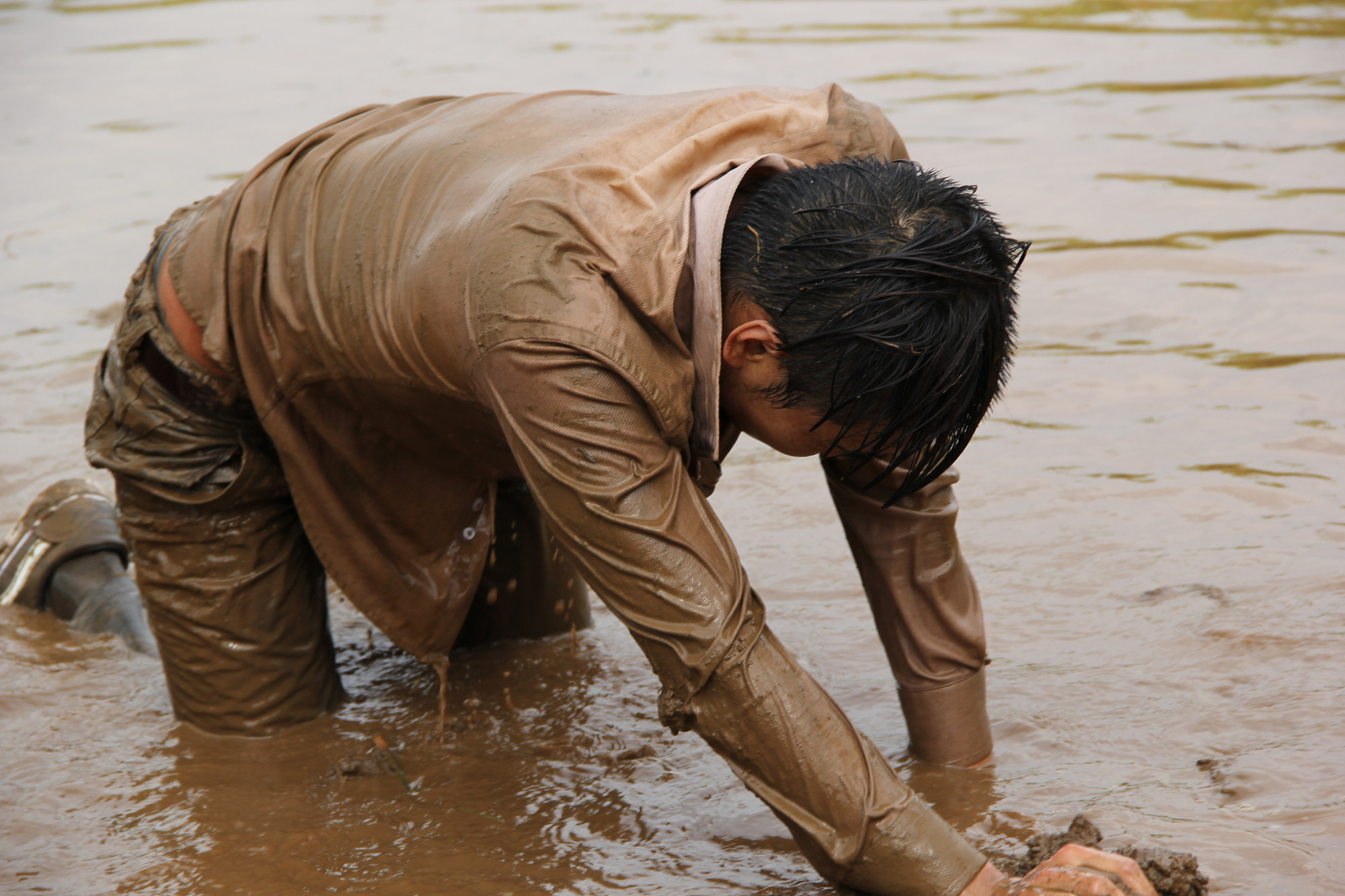
______________
Helmut Smits Dead Pixel in Google Earth, 2009
burned square, the size of one pixel from an altitude of 1 km.
![]()
![]()
______________
Alastair Mackie Mud Hut, 2010
mud, straw, and horse manure

______________
Ugy Sugiarto Various, 2009
acrylic on canvas

Immortal Fighting
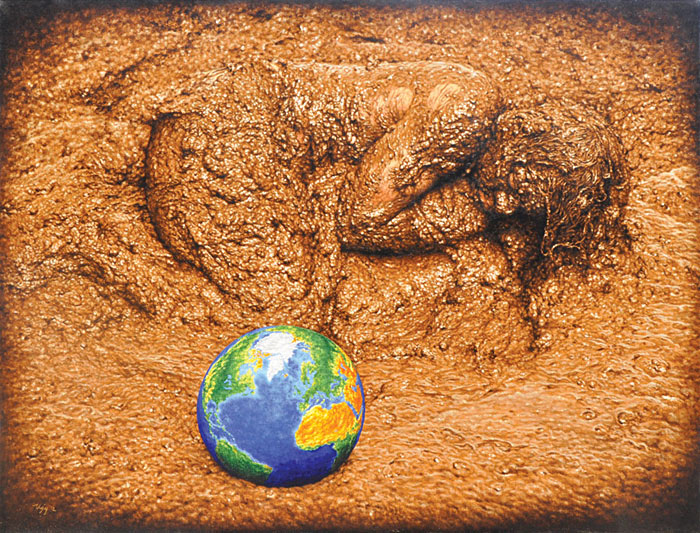
Don’t Let Me Drown
_______________
Xuhong Shang Horizon, 1995
wooden deck, painted baseboard, mud, branch bark, plant

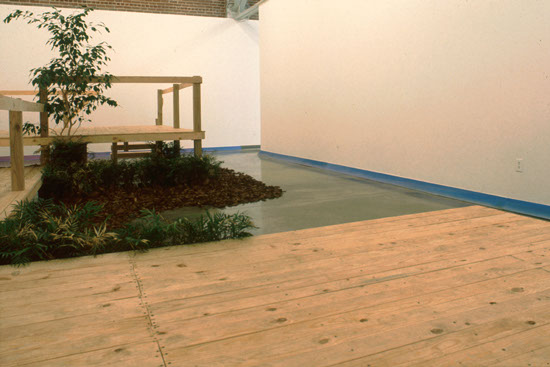

_____________
Ashby Lee Collinson Episode XVI: Princess Dies – The Crowning, 2011
Airing on Portland Community Media: 5/15/11 10:30 pm Sun — Channel 22, 5/21/11 12:00 am Sat — Channel 11, 5/27/11 11:00 pm Fri — Channel 23
_____________
James Croak Dirt Baby, 1988
cast mud
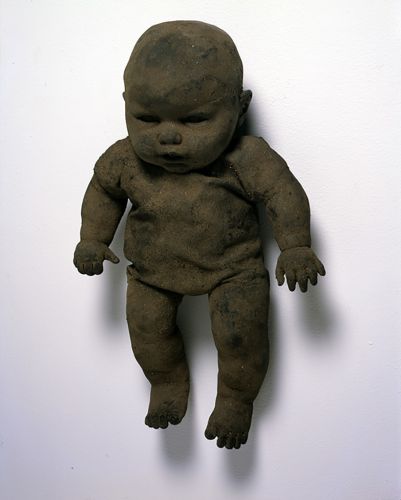
_____________
Dineo Seshee Bopape Mabu, Mubu, Mmu, 2017
Soil, mud, ceramics, herbs, crystals, coal, ash created with a clenched fist.
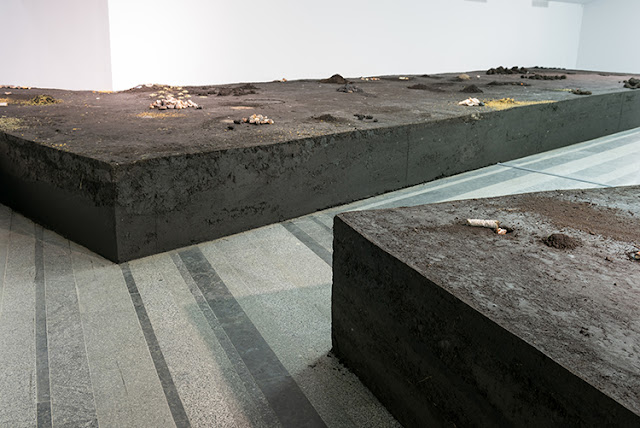
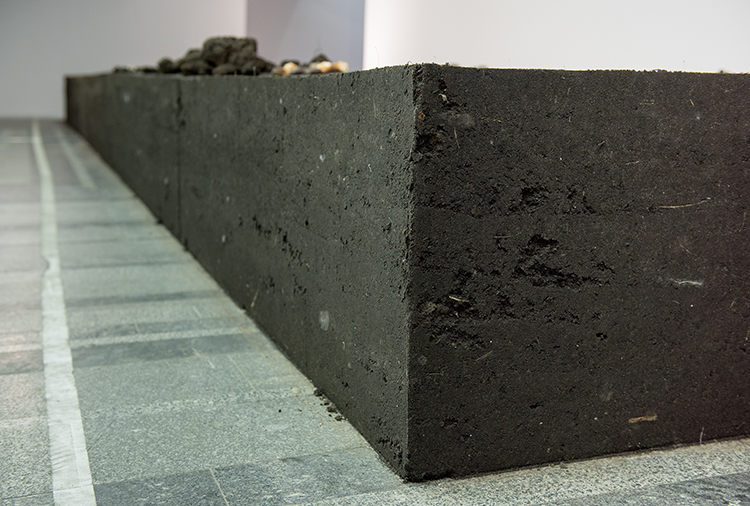
_____________
Chris Burden Exposing the Foundation of the Museum, 1986
‘The installation, known as the Exposing the Foundation of the Museum, comprises three trenches next to the exterior walls. Visitors descend the excavation or tunnel to witness the concrete footing.’
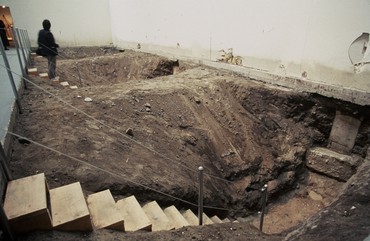
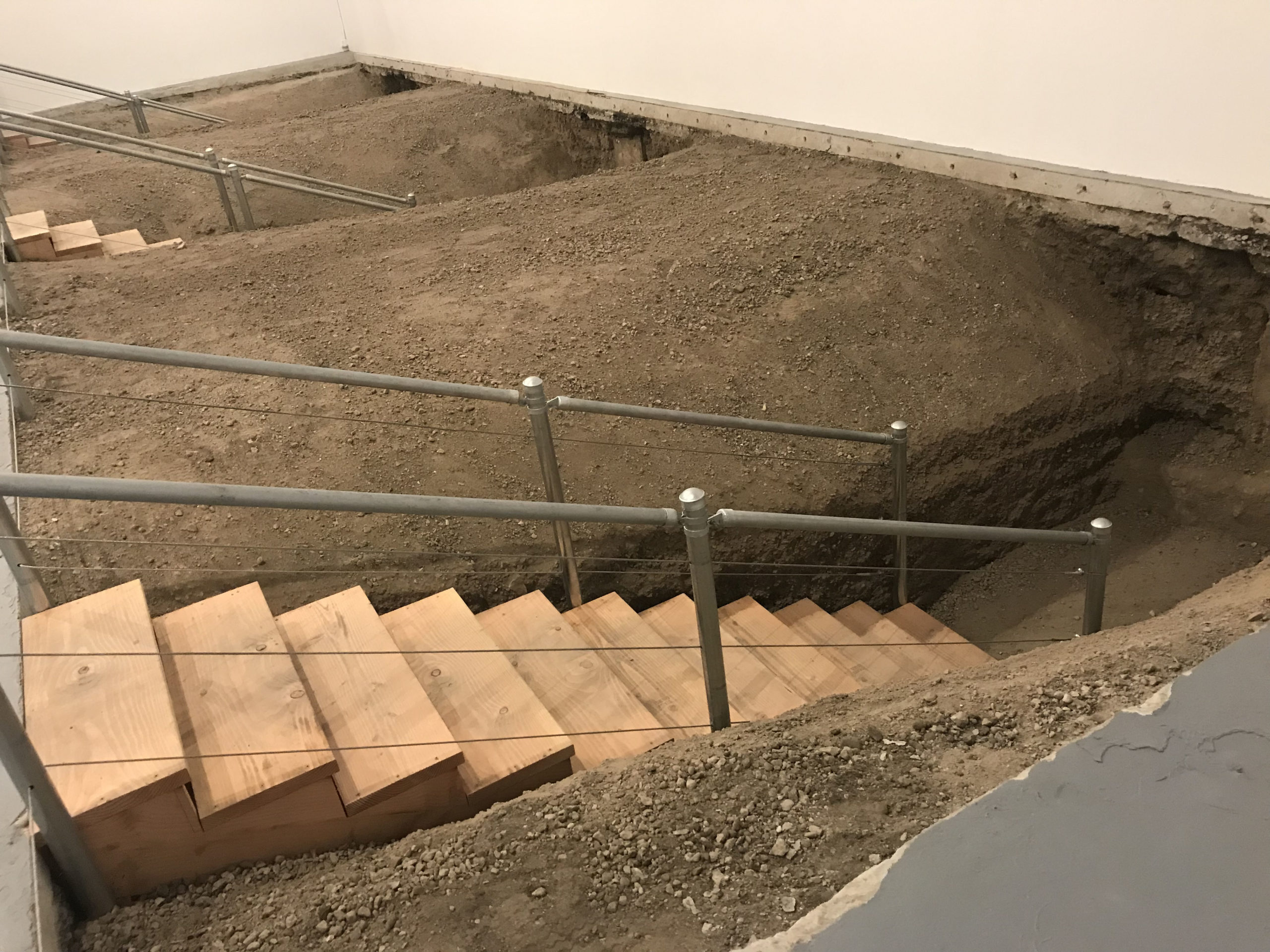
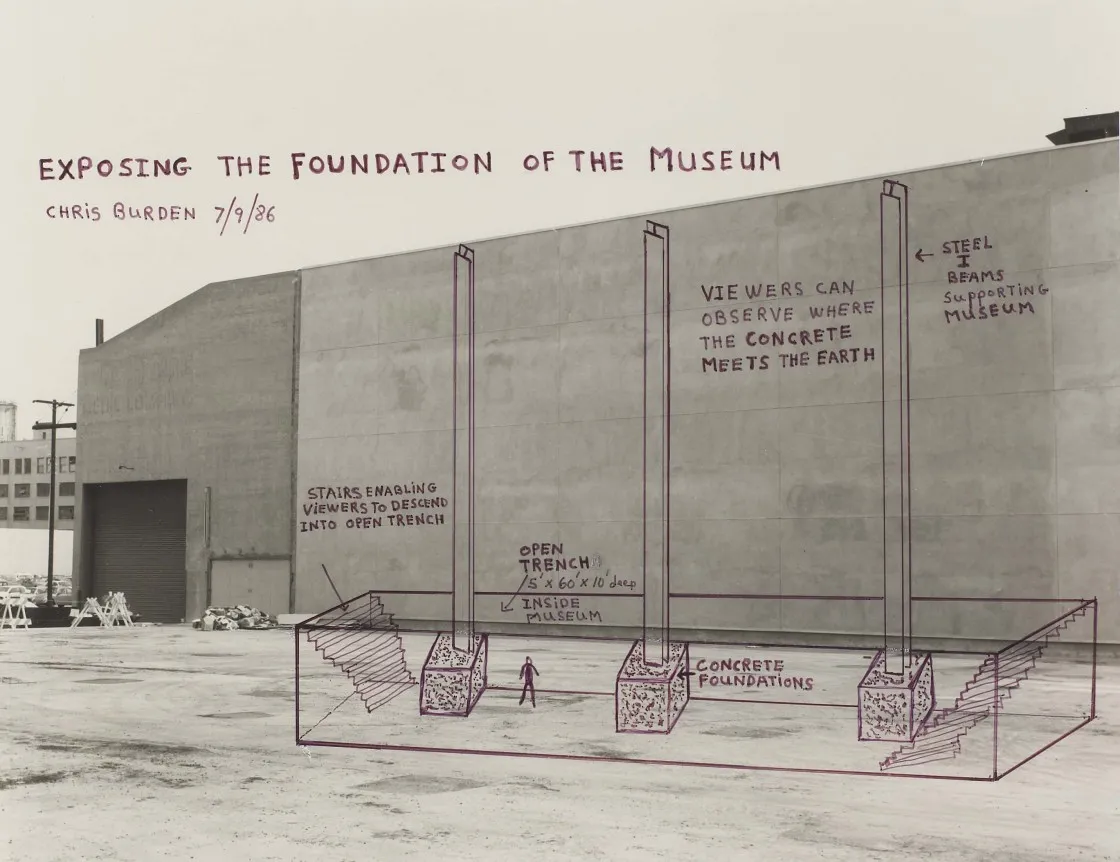
_____________
Urs Fischer You, 2007
‘You was an eight-foot deep crater that measured approximately 11,6 x 9,1 m (38 x 30 ft.), extending almost to the walls of the gallery. According to New York Magazine, the pit took ten days to build and approximately $250,000. The same report shows that it was dug using jackhammers to remove the concrete floor. The workers used a backhoe to clear the tons of debris around the area. A sign at the door warned: THE INSTALLATION IS PHYSICALLY DANGEROUS AND INHERENTLY INVOLVES THE RISK OF SERIOUS INJURY OR DEATH.’


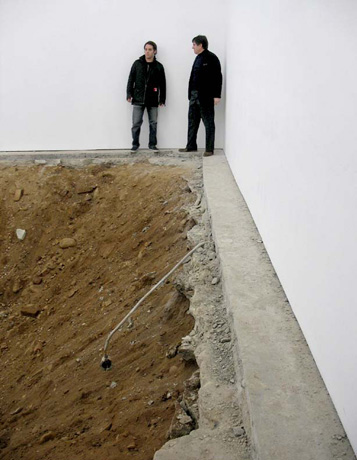
_____________
Rabyn Blake Mudpool, 1976
‘Splatter. Plop. Plop. Plop. A dribble of thick liquid spatters down into a growing mound of silver sludge. Then the scene changes and we see insects, a toad, and other small life-forms sitting patiently as their ecosystem awakens. The ground begins to move as human bodies slowly start churning liquid earth into a slurry of dirt that coats their skins. This is how Rabyn Blake’s revolutionary video artwork Mudpool (1976) begins.
‘The work is as sensual as it is strange. As the eight-minute black-and-white video progresses, we see figures emerging out of a primordial soup, then resubmerging their naked bodies in the silky mud. A reclining man sits up in the sunken pool, syrupy mud pouring down over his face and through his long hair and beard. The camera pans closer, closer, as corporeal forms roll and tumble, their movements and shapes evocative of concrete mixers, classical reliefs, lovers in bed, slow-motion mud wrestling. We can feel the suction as the thick liquid blanket sleeves over their trunks and limbs. It is strange in its uncanny familiarity; it feels both timeless and ancient. We are watching Mother Earth devour bodies and return them to their origins.
‘Understanding the context of Mudpool has been, for me, like picking through the tufts of a floor carpet, searching for small crumbs that escaped the oblivion of time—the great existential vacuum cleaner. Very few of Blake’s artworks are extant. Next to nothing is archived online, and the community of people who knew her is fading away. The lack of information plagues much early video work, and of course most performative and participatory happenings that were experiential and pre-internet. It is also no surprise that Blake’s work has not received greater acknowledgement in what was (and is still) a male-dominated field.’
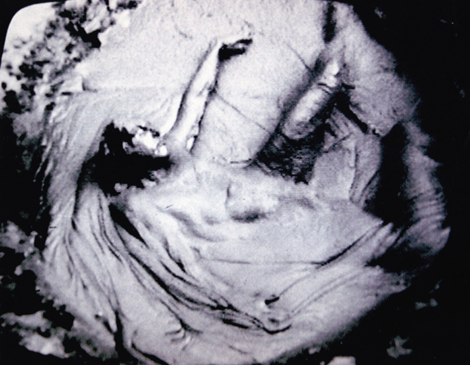
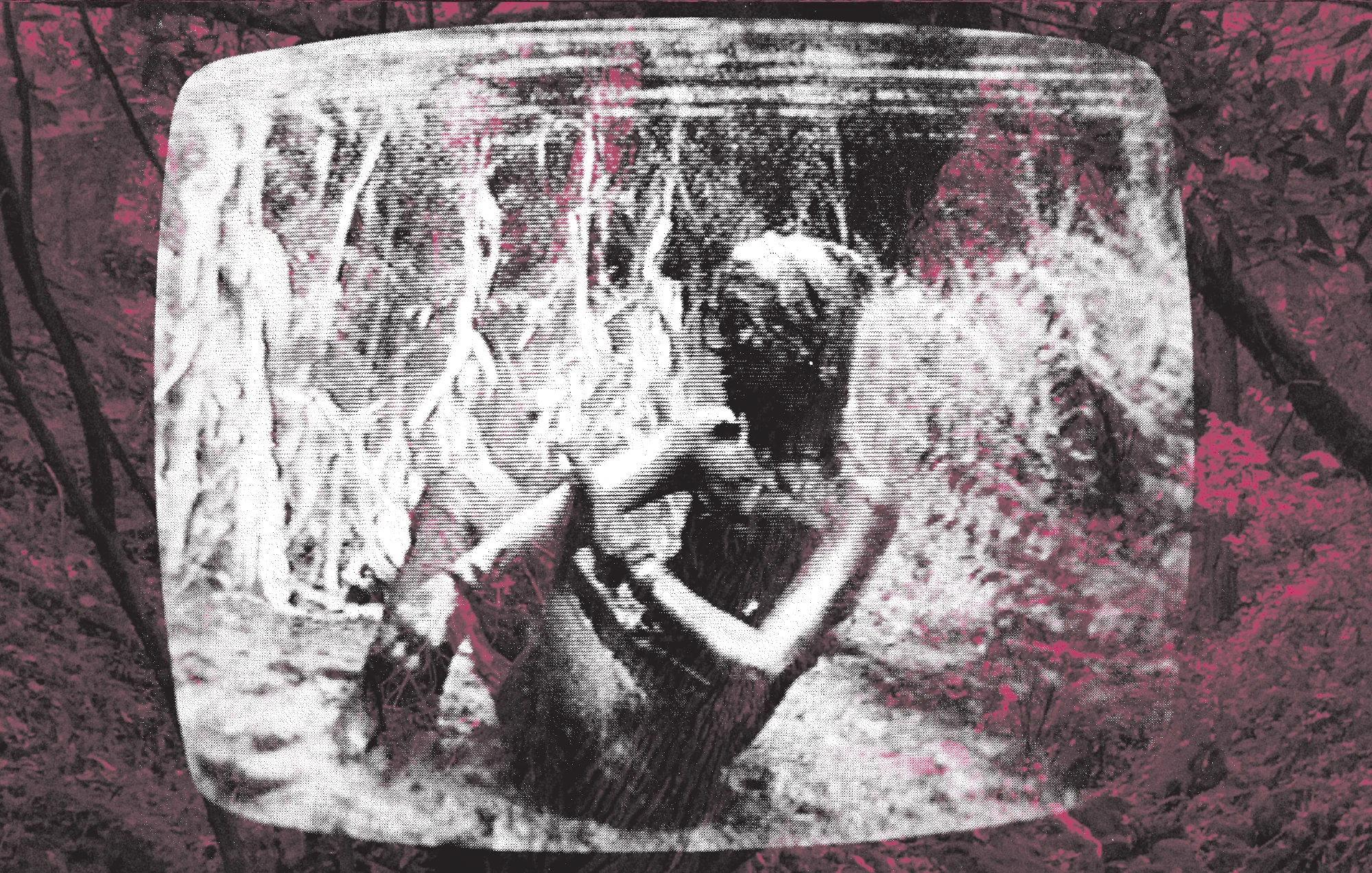
_____________
Andrew Birk Life Shroud, 2017
‘Andrew Birk presents a series of Life Shrouds, an exercise of dirt-on-denim pieces made with the imprint of his own body. Dirt is pigment and denim is canvas; dirt is body and denim is labour. Stripping down art history’s canons and praising the unrefined, Birk uses wearable, industrial cloth, to cover himself covered in mud. As in a death shroud, body and dirt become one thing in a cycle of both scientific and religious undertones. Beyond the anthropocentric and constructed distinction between artificial and natural, human beings appear as an undivided species within a larger system of entities, living in a world of structures – biological, social, linguistic. Seen as accumulations of materials formed and solidified through time, historical narratives then become geological, and humans, made from synthetic processes and constantly provoking new ones, like rocks and plants and bacteria, become a planetary force.’
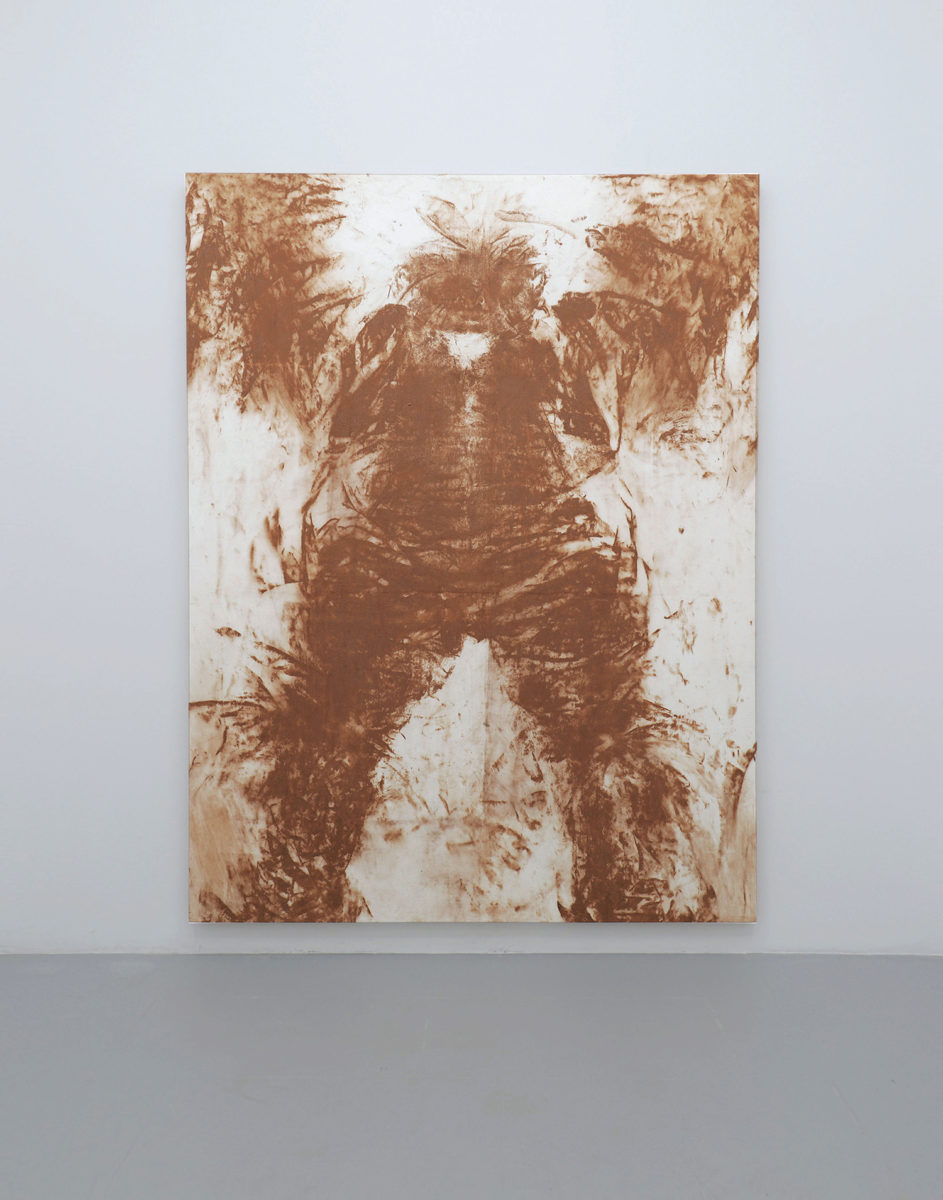
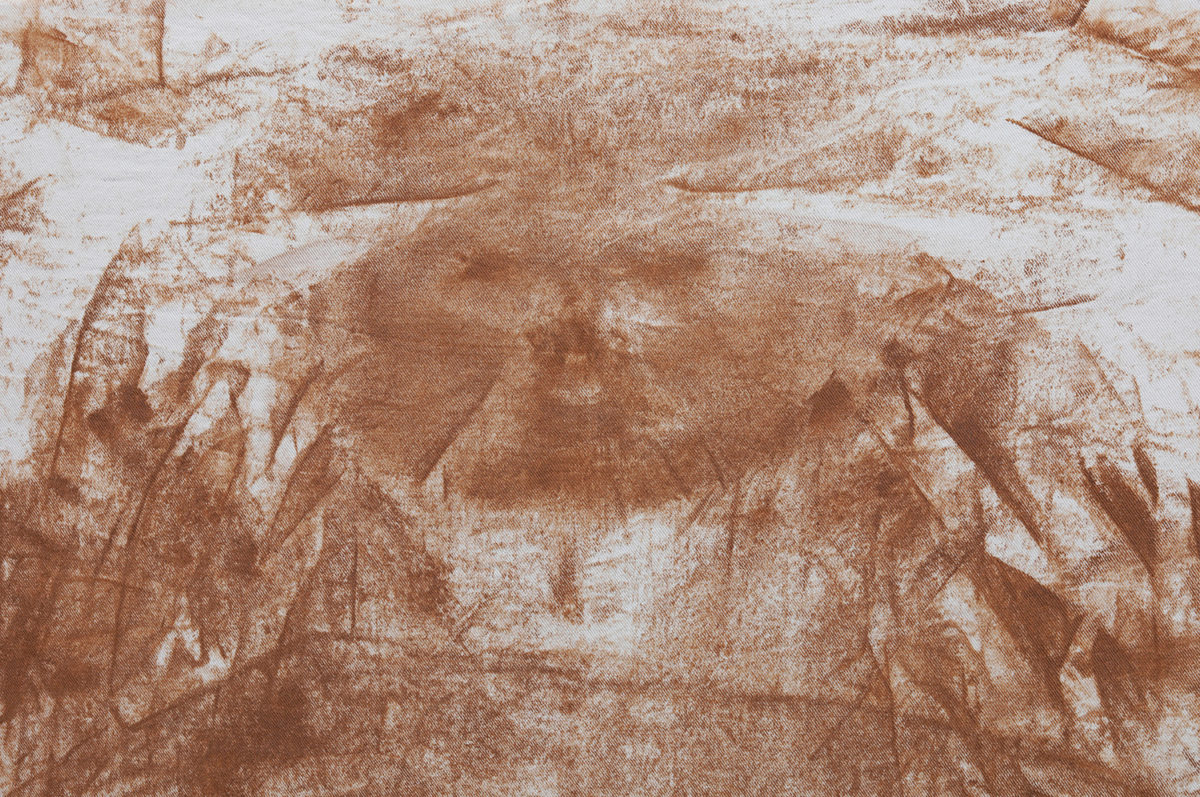
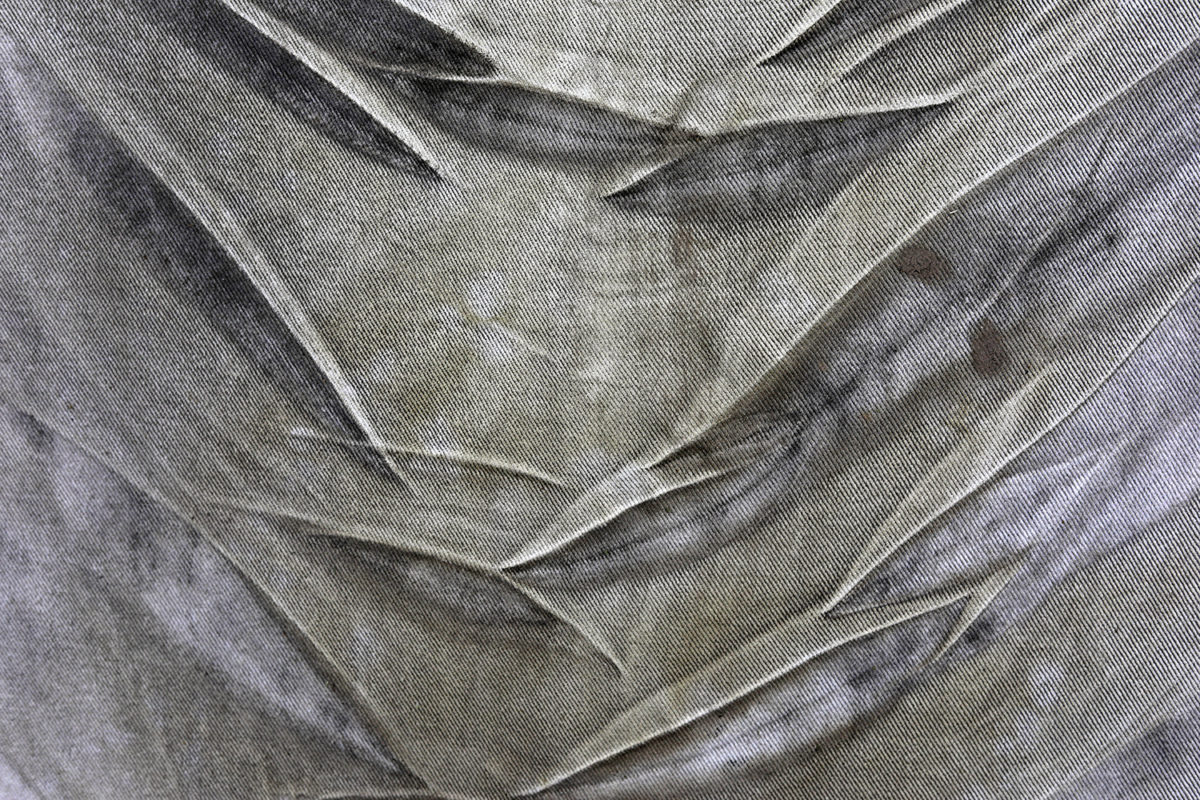
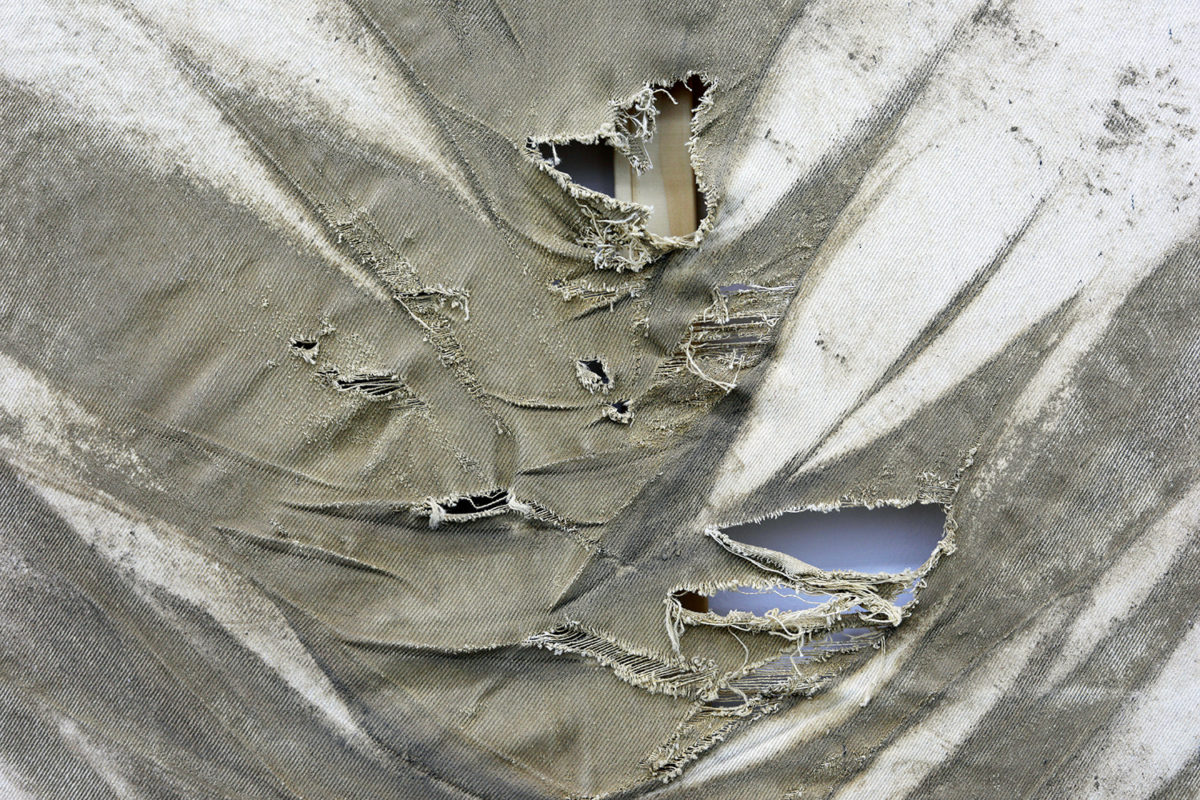
____________
Jack Woods Equinox, 1970
‘Four friends are attacked by a demon while on a picnic, due to possession of a tome of mystic information.’
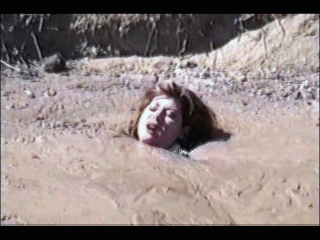
____________
Petrit Halilaj Kostërrc, 2011
‘Kostërrc, the work—which filled an entire gallery, leaving its gallerists to hover in the lane just outside—comprised a perfect wave of dirt about to break. At its crest was a hint of grass, like tufts of green-blue hair. The earthy smell of the soil (60 tons of it) and the sod was oddly gratifying. The soil was excavated from the hill in Kosovo where the artist was born, then brought to Switzerland on a truck.’
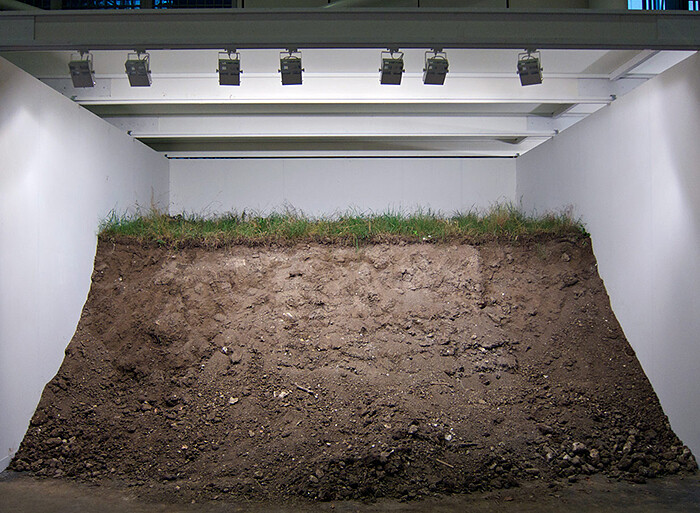
____________
Richard Bartle MUD, 1978
‘MUD was created in 1978 by Roy Trubshaw at Essex University on a DEC PDP-10 in the UK. Richard Bartle, a fellow Essex student, contributed much work on the game database, introducing many of the locations and puzzles that survive to this day. Later that year Roy Trubshaw graduated from Essex University, handing over MUD to Richard Bartle, who continued developing the game. That same year, MUD1 became the first Internet multiplayer online role-playing game as Essex University connected its internal network to the ARPAnet. In 1983, Essex University allowed remote access to its DEC-10 via British Telecom’s Packet Switch Stream network between 2 am and 7 am each night. MUD became popular with players around the world, and several magazines wrote articles on this new trend.’
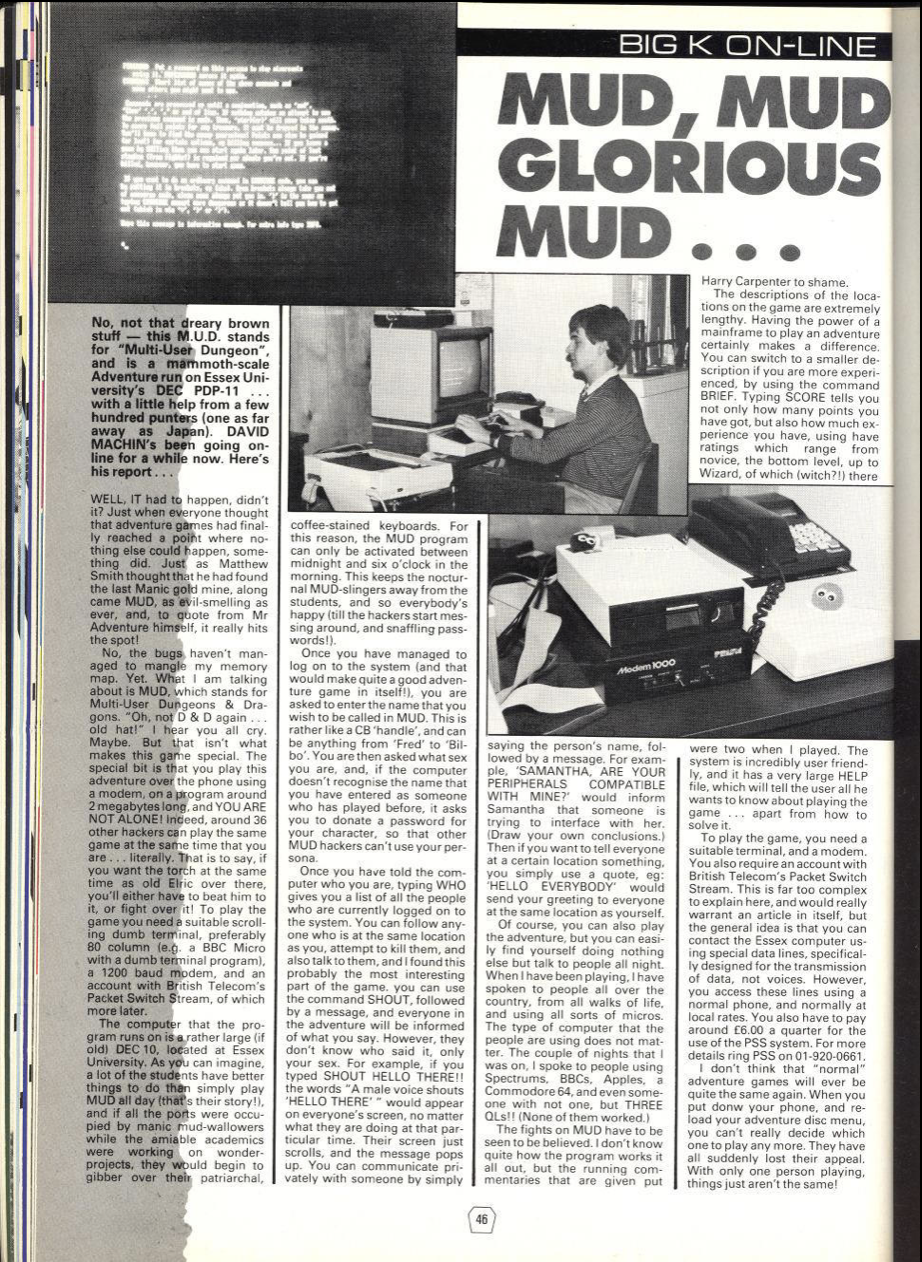
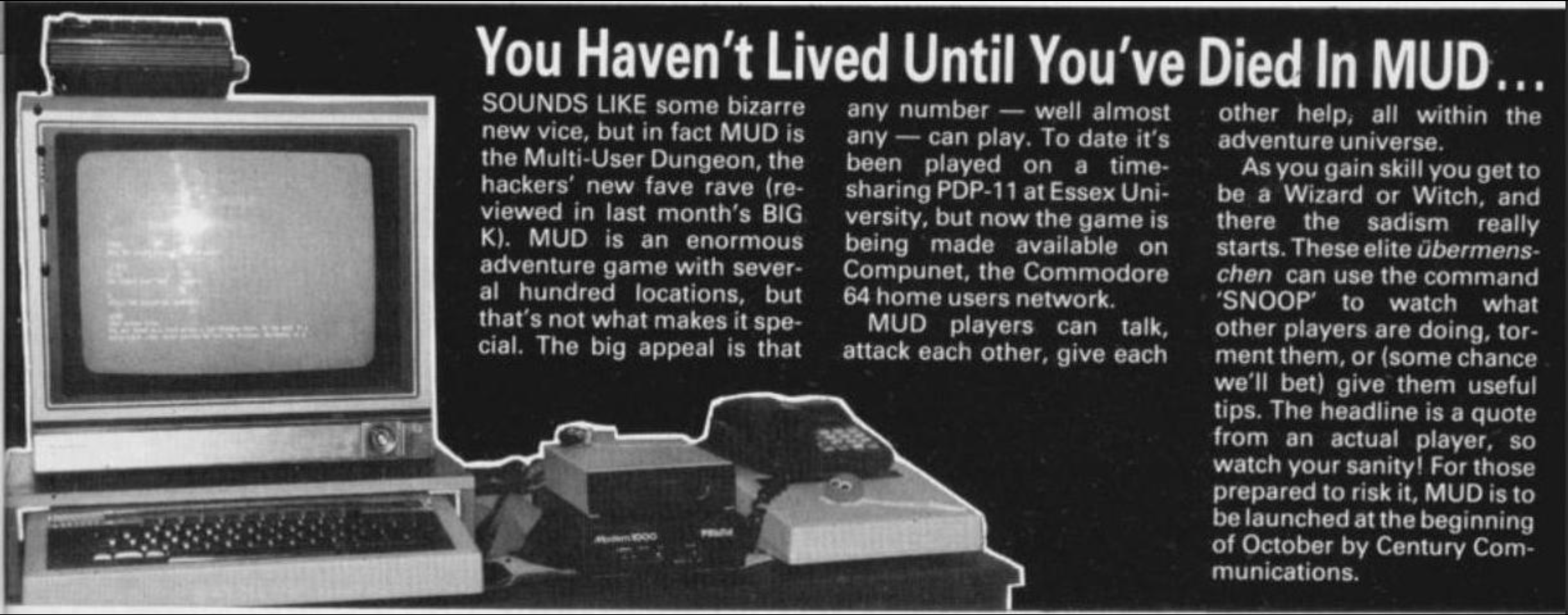
*
p.s. Hey. ** David Ehrenstein, Gilliam’s version is an homage to Zeman’s. ** Stephen M, Hi, Stephen. Thanks much for the suggestions. That’s where I’ll go. Hope all’s great with you. ** _Black_Acrylic, Zeman seems to be the animation equivalent of the writers’ writer, hugely influential in the field but not so known outside of it. Strange that. I was with some friends on Saturday, and things got a little dull, so I put on Play Therapy, and awkward silence was replaced with bliss-faced wiggling and nodding, and you saved yet another day! ** Yards-a Thorns, Hi there. Intriguing and excellent name. Thank you, my total pleasure. Yes, super shocking about the Oslo incident. Huge hopes that it was an isolated madness. Sleep is precious, just ask my friends in the USA. I’m so sorry you’re having to go through that. Stay imaginative and optimistic, it’s very important. xo. ** Billy, Hi, Billy. Yes, I’ve been really intrigued by Dall.e mini and what it’s capable of. Thank you for the nudge. I’ll go wade in and see what happens. You doing great, I hope? ** Bill, There’s some truly gorgeous stuff visually in his films. Still mind-blowing in places, even now. I don’t imagine the Charles Busch film will play here, although it might get screened perhaps. I’ll peel my eyes and look online if nothing else. It’s truly terrifying about the Supreme Court. Boy, if that shit doesn’t finally wake people over there the fuck up, I don’t know what will. Here in France the govt. is reacting by proposing to enshrine abortion rights in the constitution. ** Impossible Princess, Yes, please do let me know how you get on with the Princess. Mm, I don’t remember any weekend twinks. Well, across the metro cars, which is good enough. I’m happy you’re getting your mojo back, needless to say. It’s your greatest weapon. I was sure I’d done a Mishima post, but I just did a search of the blog’s archives and came up empty. Weird. I will do one of some sort soon. Mm, I think my favorite is still ‘Confessions of a Mask’. Kind of a boring choice, but … I liked the ‘Sea of Fertility’ novels a lot when I read them ages ago. And ‘The Black Lizard’. Off the top my head. Kisses back from the mere DC. ** Misanthrope, Wow, that sounds kind of exciting to me, but I’ve never had a desk job, so what the fuck do I know. How was it? ** Jeff J, Hi, Jeff. Very happy that post was of use. I can watch the Criterion Channel with VPN but the connection is really, really slow, so it’s kind of a big chore to watch things on there, but I do, of course. What is the translation problem with ‘SL’, do you know? That they cant get the rights to the original translation or they don’t like it or their new translation isn’t good enough or … ? You probably don’t know. I should just ask Hedi. Novels just get slow sometimes. I figure they need to for some reasons. As long as it’s growing, you know? Nice about the Julien Calendar gig. It’s been ages. A fair number of people with good taste like ‘Memoria’, but I still think it’s a misfire. See what you think. ** Right. I’m giving you some conceptual mud to play in conceptually today, so to speak. See you tomorrow.




 Now available in North America
Now available in North America 
Take It Away, BING!
I only ever went to 2 incarnations of the Glastonbury festival, in ’97 and ’98. Both years were notably muddy, but 98 was by far the worst. I remember watching more of the World Cup in a neighbouring field than seeing actual live music that weekend. This year’s edition has just finished and it’s more of a media event for Guardian and BBC journalists these days. In my view, festivals are most definitely a young man’s game.
*A young person’s game, I mean to say.
No clips of the glam band Mud?
Have you read Edouard Louis? I finished WHO KILLED MY FATHER? yesterday and was really moved by it. It’s a worthy successor to Peter Handke’s A SORROW BEYOND DREAMS, which he cited as an influence. I’ve read A HISTORY OF VIOLENCE and liked it, but not nearly as much.
Sebastiane
Dennis, It was a’ight. I woke up this morning after being a little anxious over the weekend and was like, “Okay, just go in there and own that motherfucker like you always did.”
Was good to see some people I like. There weren’t many people there at all anyway. Kinda boring most of the day, hahaha.
Next day in is the 11th. July 4 is on Monday and that’s my day in, so…it’s accounted for. 😀 Which is why I picked Monday to go in every week.
I like the mud baby. He’s cute. Or she is. Luckily, I don’t have a mud phobia. (Or a balloon one, I forgot to tell you, nope, don’t have that. But man, I do have a lot of phobias.)
Lots of work to do tomorrow. Eek.
I’ll probably see that Jurassic movie this weekend. Saturday.
Otherwise, just faking it until I make it.
Or something like that. 😀
Wow, so hard to keep up here. I wanted to mention that I saw one of those Boyle family sculptures in a private collection once and it was impressive… somewhat monumental, looked like a real slice of life although, of course, no actual mud was involved in its construction. I marveled at the technical prowess and size (I remember it being maybe 6-8 inches thick and maybe 10′ x 15′) but found myself wondering what the point was. Anyways, thanks for always keeping it interesting…
Hey Dennis – Enjoyed the mud today! The Burden and the Birk pieces jumped out for whatever reason. I immediately thought of Maria Irene Fornes’ great play MUD. Have you done a Fornes day?
For the past few weeks, some of the blog’s images aren’t showing up for me. I’ve viewed the blog via several different browsers and the same images would be problematic on all of them. I mention this in case other people are experiencing this glitch, too?
Strange Landscape – I think Hedi said he didn’t like or trust the existing translation. Something like that. If you talk to him about it, let me know what he says. It’d be great to have it back in print.
I was catching up on Bookworm episodes and was startled to see there haven’t been any new ones in like 6 weeks. And before that there were lots of reruns and Michael’s producer hosted a show or two. Do you know what’s happening? Hoping everything is okay.
A fine muddy Monday, Dennis. I’ve been on a butoh kick lately, so bodies writhing in the mud have been showing up on my screens regularly. Just finished the encyclopedic Routledge Companion to Butoh, checked out various videos online, including the short doc Piercing the Mask (some great footage, but frustrating). Will probably revisit Michael Blackwood’s longer and better known butoh doc soon.
Good to hear the French might be formally confirming abortion rights. Yeah, what’s happening here is pretty horrific.
Bill